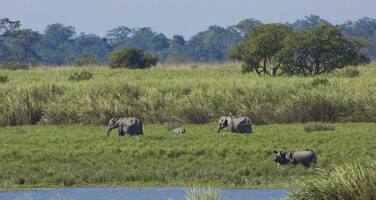Kaziranga National Park
Factors affecting the property in 2000*
- Flooding
- Illegal activities
- Management systems/ management plan
Factors* affecting the property identified in previous reports
- Flooding
- Rhino poaching
- Need to raise awareness among local villagers of the importance of the World Heritage status of Kaziranga
International Assistance: requests for the property until 2000
Total amount approved : 50,000 USD
| 1997 | Support to Strengthening Protection of Kaziranga ... (Approved) | 50,000 USD |
Missions to the property until 2000**
Information presented to the Bureau of the World Heritage Committee in 2000
Previous deliberations:
Twenty-third session of the Committee – paragraph X.28 and Annex VIII
Twenty-third ordinary session of the Bureau – paragraph IV.33
New Information: IUCN has informed the Centre that the State Party has developed a 5-year Action Plan including a calendar for its implementation for the site and focusing on anti-poaching activities and habitat management. The twenty-third extraordinary session of the Bureau (Marrakesh, 1999) requested the State Party to inform the Centre whether it intends to include a recent extension of 44 square kilometres into the World Heritage site. The Director of the Park in a report to the Chief Conservator of Forests dated 17 February 2000 and transmitted to the Centre by UNESCO, New Delhi, has noted that the decision concerning the extension is yet to be ratified by the legislature of the Assam State. Hence, a formal proposal for the extension of the World Heritage site would have to await the approval by the State legislature. The report of the Director notes that erosion damage caused by the 1998 floods has to be studied and suggested that UNESCO be contacted for funds for financing such studies. The Centre has been offered a sum of DM 10,000 by a German Tour Operator (Windrose), with the support and encourgaement of the UNESCO National Commission of Germany, for use in the protection of Kaziranga National Park. The Centre is in contact with the UNESCO Office in New Delhi and the Director of the Kaziranga National Park in order to mobilise the DM 10,000 for undertaking studies on erosion damage caused by the 1998 floods.
The Secretariat will commend the State Party for elaborating a 5-year action plan and encourage the setting aside of adequate resources for its implementation. The State Party will be requested to keep the Centre informed of progress in the approval of the proposed extension to the Park by the legislature of the Assam State of India. The Centre will facilitate the transfer of the donation of DM 10,000 offered by a German Tour Operator for undertaking studies on damage caused by soil erosion in Kaziranga and report the findings of the study to the twenty-fifth session of the Bureau in 2001.
Action Required
Summary of the interventions
Decisions adopted by the Committee in 2000
24 BUR IV.B.78
State of conservation
The Bureau took note of the information provided in the working document on the state of conservation of the following properties:
NATURAL HERITAGE
Comoe National Park (Côte d’Ivoire)
Caves of the Aggtelek and Slovak Karst (Hungary/Slovakia)
The Delegate of Morocco pointed out that the protection of surface water is important in karst systems.
Kaziranga National Park (India)
Lorentz National Park (Indonesia)
Kamchatka Volcanoes (Russian Federation)
Sinharaja Forest Reserve (Sri Lanka)
Bwindi Impenetrable Forest (Uganda)
CULTURAL HERITAGE
Rock-hewn Churches, Lalibela (Ethiopia)
Vilnius Historic Centre (Lithuania)
City of Cuzco (Peru)
Chavin (Archaeological Site) (Peru)
Lines and Geoglyphs of Nasca and Pampas de Jumana (Peru)
* :
The threats indicated are listed in alphabetical order; their order does not constitute a classification according to the importance of their impact on the property.
Furthermore, they are presented irrespective of the type of threat faced by the property, i.e. with specific and proven imminent danger (“ascertained danger”) or with threats which could have deleterious effects on the property’s Outstanding Universal Value (“potential danger”).
** : All mission reports are not always available electronically.


